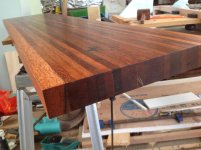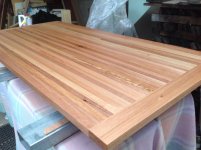So I'm fixing up our laundry, we have a nook that's about 100inches wide, the idea is to have the washer and dryer in the center, 15inch cabinets on either side, and top it off with butcher block counters. The counters are ikea numerar, 39 3/8 deep, by 73 wide, and that's where the question comes. I have a df500, and my plan is to join two pieces of counter to hit the 100inches, I'm going to use 10*50mm dominos. I'm thinking that 30-40mm i. Between dominos should do fine, but should I reinforce the bottom of the counter with some iron?
Also, I forgot to mention, the counter will be supported fully along the back, and by the flanking cabinets, so the "seam" will be supported at the rear of the counter, but the rest of it will be floating.....
Also, I forgot to mention, the counter will be supported fully along the back, and by the flanking cabinets, so the "seam" will be supported at the rear of the counter, but the rest of it will be floating.....


